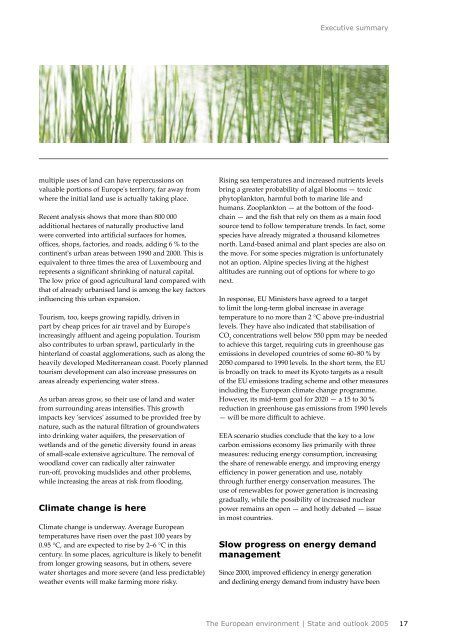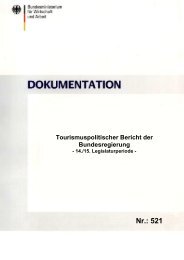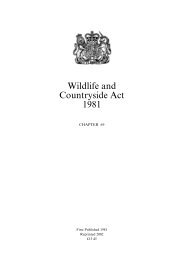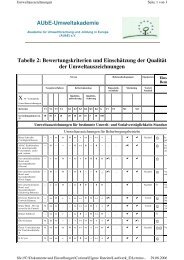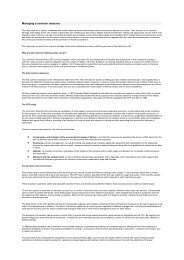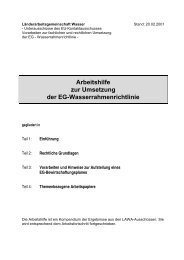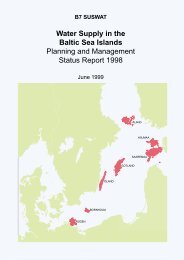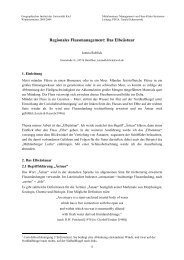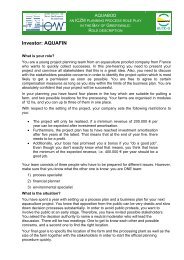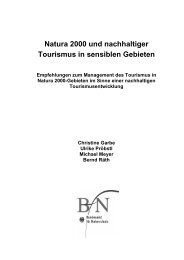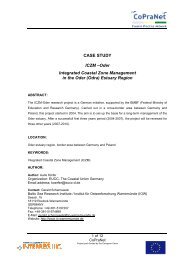The European environment - State and outlook ... - IKZM-D Lernen
The European environment - State and outlook ... - IKZM-D Lernen
The European environment - State and outlook ... - IKZM-D Lernen
Create successful ePaper yourself
Turn your PDF publications into a flip-book with our unique Google optimized e-Paper software.
Executive summary<br />
multiple uses of l<strong>and</strong> can have repercussions on<br />
valuable portions of Europe's territory, far away from<br />
where the initial l<strong>and</strong> use is actually taking place.<br />
Recent analysis shows that more than 800 000<br />
additional hectares of naturally productive l<strong>and</strong><br />
were converted into artificial surfaces for homes,<br />
offices, shops, factories, <strong>and</strong> roads, adding 6 % to the<br />
continent's urban areas between 1990 <strong>and</strong> 2000. This is<br />
equivalent to three times the area of Luxembourg <strong>and</strong><br />
represents a significant shrinking of natural capital.<br />
<strong>The</strong> low price of good agricultural l<strong>and</strong> compared with<br />
that of already urbanised l<strong>and</strong> is among the key factors<br />
influencing this urban expansion.<br />
Tourism, too, keeps growing rapidly, driven in<br />
part by cheap prices for air travel <strong>and</strong> by Europe's<br />
increasingly affluent <strong>and</strong> ageing population. Tourism<br />
also contributes to urban sprawl, particularly in the<br />
hinterl<strong>and</strong> of coastal agglomerations, such as along the<br />
heavily developed Mediterranean coast. Poorly planned<br />
tourism development can also increase pressures on<br />
areas already experiencing water stress.<br />
As urban areas grow, so their use of l<strong>and</strong> <strong>and</strong> water<br />
from surrounding areas intensifies. This growth<br />
impacts key 'services' assumed to be provided free by<br />
nature, such as the natural filtration of groundwaters<br />
into drinking water aquifers, the preservation of<br />
wetl<strong>and</strong>s <strong>and</strong> of the genetic diversity found in areas<br />
of small-scale extensive agriculture. <strong>The</strong> removal of<br />
woodl<strong>and</strong> cover can radically alter rainwater<br />
run-off, provoking mudslides <strong>and</strong> other problems,<br />
while increasing the areas at risk from flooding.<br />
Climate change is here<br />
Climate change is underway. Average <strong>European</strong><br />
temperatures have risen over the past 100 years by<br />
0.95 °C, <strong>and</strong> are expected to rise by 2–6 °C in this<br />
century. In some places, agriculture is likely to benefit<br />
from longer growing seasons, but in others, severe<br />
water shortages <strong>and</strong> more severe (<strong>and</strong> less predictable)<br />
weather events will make farming more risky.<br />
Rising sea temperatures <strong>and</strong> increased nutrients levels<br />
bring a greater probability of algal blooms — toxic<br />
phytoplankton, harmful both to marine life <strong>and</strong><br />
humans. Zooplankton — at the bottom of the foodchain<br />
— <strong>and</strong> the fish that rely on them as a main food<br />
source tend to follow temperature trends. In fact, some<br />
species have already migrated a thous<strong>and</strong> kilometres<br />
north. L<strong>and</strong>-based animal <strong>and</strong> plant species are also on<br />
the move. For some species migration is unfortunately<br />
not an option. Alpine species living at the highest<br />
altitudes are running out of options for where to go<br />
next.<br />
In response, EU Ministers have agreed to a target<br />
to limit the long-term global increase in average<br />
temperature to no more than 2 °C above pre-industrial<br />
levels. <strong>The</strong>y have also indicated that stabilisation of<br />
CO 2<br />
concentrations well below 550 ppm may be needed<br />
to achieve this target, requiring cuts in greenhouse gas<br />
emissions in developed countries of some 60–80 % by<br />
2050 compared to 1990 levels. In the short term, the EU<br />
is broadly on track to meet its Kyoto targets as a result<br />
of the EU emissions trading scheme <strong>and</strong> other measures<br />
including the <strong>European</strong> climate change programme.<br />
However, its mid-term goal for 2020 — a 15 to 30 %<br />
reduction in greenhouse gas emissions from 1990 levels<br />
— will be more difficult to achieve.<br />
EEA scenario studies conclude that the key to a low<br />
carbon emissions economy lies primarily with three<br />
measures: reducing energy consumption, increasing<br />
the share of renewable energy, <strong>and</strong> improving energy<br />
efficiency in power generation <strong>and</strong> use, notably<br />
through further energy conservation measures. <strong>The</strong><br />
use of renewables for power generation is increasing<br />
gradually, while the possibility of increased nuclear<br />
power remains an open — <strong>and</strong> hotly debated — issue<br />
in most countries.<br />
Slow progress on energy dem<strong>and</strong><br />
management<br />
Since 2000, improved efficiency in energy generation<br />
<strong>and</strong> declining energy dem<strong>and</strong> from industry have been<br />
<strong>The</strong> <strong>European</strong> <strong>environment</strong> | <strong>State</strong> <strong>and</strong> <strong>outlook</strong> 2005<br />
17


